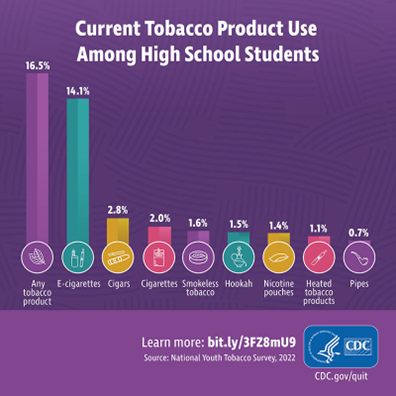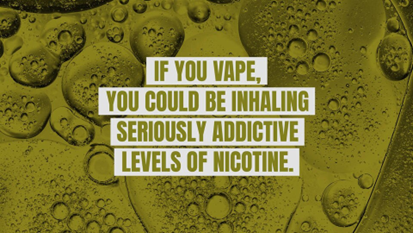Home > PTTC Post Article - November 2023
Author: Cele Fichter-DeSando, MPM
E-cigarette use among youth in the United States remains a top health concern. E-cigarettes entered the U.S. marketplace around 2007, and since 2014, they have been the most commonly used tobacco product among U.S. youth (CDC, 2018). The 2022 National Youth Tobacco Survey found that about one in ten or 2.5 million U.S. middle and high school students reported current e-cigarette use. Almost half of high schoolers who use e-cigarettes (or “vape”) do so on a near-daily basis. Near-daily usage puts individuals at risk for a potential lifetime of nicotine dependence and tobacco use disorders and at an increased risk for developing other substance use disorders (FDA, 2022).

E-cigarette use among youth presents a variety of dangers. Risks of nicotine exposure during adolescence can harm brain development and lead to addiction. The health risks of vaping among youth and young adults include respiratory ailments; negative impacts on attention, learning, and memory; and exposure to toxic ingredients contained in vaping products. The long-term effects related to exposure to vaping products remain unknown (SAMHSA, 2020).
National Youth Tobacco Survey 2022 Findings
Source: Results from the Annual National Youth Tobacco Survey
|
E-cigarette unit sales increased by 46.6% between January 2020 and December 2022. The E-cigarette Unit Sales Study published in the June 23, 2023 Center for Disease Control and Prevention (CDC) Morbidity and Mortality Weekly Report, found that the total number of e-cigarette brands increased by 46.2% during that time, from 184 to 269 (Ali et al, 2023). Disposable e-cigarettes sold in the U.S. nearly tripled in nicotine strength, quintupled in e-liquid capacity, and dropped in price by nearly 70% between 2017 and 2022, according to a recent Truth Initiative Study. The study of e-cigarette sales data finds that 2022 alone saw the debut of 48 disposable e-cigarettes with 6% or greater nicotine strength as well as 18 products with a 20-milliliter capacity – 29 times the size of a JUUL pod (Diaz et al., 2023).
The Truth Initiative Study concluded that “the increasing size and strength of disposable e-cigarettes has resulted in a generation of products with nicotine levels comparable to several cartons of cigarettes, while price drops have nearly tripled the purchasing power for price-sensitive youth. The market’s evolution indicates a need to limit e-cigarette sizes, establish minimum prices, and cap nicotine levels to prevent young people from becoming hooked to cheap, highly addictive nicotine products” (Diaz et al., 2023).
Research has shown that national, state, and local program activities reduce and prevent youth tobacco product use when implemented together (CDC, 2022). These activities include:
Implementing new programs or policies requires a comprehensive, multi-pronged approach, and there are many resources available to prevention professionals, policymakers, teachers, communities, and parents to address e-cigarette usage among children and youth.
A SAMHSA-developed guide, Reducing Vaping Among Youth and Young Adults, discusses programs and policies to reduce and prevent vaping among youth and young adults that can be used by policymakers, community organizations, educators, and prevention and health professionals. Many of the programs and policies are modeled on evidence-based tobacco control strategies and have been adapted to address vaping among youth and young adults. More research is needed to specifically evaluate the effectiveness of the programs and policies on vaping behavior.
The U.S. Food and Drug Administration (FDA) Center for Tobacco Products developed an online resource center to provide science-based, accessible materials for teachers, parents, and teens. The Vaping Prevention and Education Resource Center is an online resource center of science-based and standards-mapped materials that teachers can use to help their students avoid vaping and nicotine addiction. The resource center features numerous age-appropriate, cross-curricular resources and materials for teachers, parents, and teens to promote learning and open conversations about youth vaping. All content at the resource center is free, easy to navigate, and optimized for each audience.
The Tobacco Education Resource Library offers posters, fact sheets, infographics, and more that are free for ordering or downloadable to print whenever or wherever you choose. There are also images available for download for web or presentation purposes.
Recognizing that some groups are more susceptible to tobacco than others, the FDA, in partnership with other organizations, has developed specific campaigns and resources for vulnerable populations.

The FDA partners with the National Cancer Institute’s (NCI) Smokefree.gov initiative to provide youth with resources for quitting e-cigarettes. Resources and information on Teen.smokefree.gov/therealcost are designed specifically for youth audiences by cessation experts. “The Real Cost” campaign connects youth to these resources on social media and various digital platforms (Spotify, Pandora, Wattpad, etc.). Some of the quit tools and resources include:

In 2022, FDA launched the Next Legends Campaign ( “Next Legends”) – a new youth e-cigarette prevention campaign that aims to educate American Indian and Alaska Native (AI/AN) youth, ages 12-17, about the harms of vaping. Native youth are more susceptible to tobacco than their non-Native peers, and they demonstrate disproportionately high experimentation and use of e-cigarettes.
The “Next Legends” campaign uses unique branding and tailored messaging that is specifically designed to educate AI/AN youth on the harmful effects of vaping.
“Next Legends” is primarily a digital-based effort designed to reach Native teens on commonly used platforms, such as YouTube, Twitch, TikTok, and Instagram. In addition to the campaign’s digital video and social media presence, out-of-home billboards, radio, and television (Alaska only) will also be used to help extend the message to AI/AN communities.
The Truth Initiative launched the “Safer ≠ Safe” campaign in 2018, focusing on correcting misperceptions and providing accurate information about e-cigarettes and youth. The campaign is being promoted on digital and social media, including the Safer ≠ Safe website, which features videos, articles, and interactive activities for youth. Truth Initiative also offers a 24/7 support network and a free texting quit tool to support quitting. In addition, The Truth Initiative has launched several campaigns around the e-cigarettes’ intersections with mental health, environmental effects, and social justice, in order to engage youth and organizations in building a healthier world.
The CDC provides Quick Facts on E-cigarette Use with fact sheets, media resources, an e-cigarette product visual dictionary, science-based information, cessation, and curricula resources outlining the risks of e-cigarette use for kids, teens, and young adults.
Ali FR, Seidenberg AB, Crane E, Seaman E, Tynan MA, Marynak K. E-cigarette Unit Sales by Product and Flavor Type, and Top-Selling Brands, United States, 2020–2022. MMWR Morb Mortal Wkly Rep 2023;72:672–677. DOI: http://dx.doi.org/10.15585/mmwr.mm7225a1
https://www.cdc.gov/mmwr/volumes/72/wr/mm7225a1.htm?s_cid=mm7225a1_w
Centers for Disease Control and Prevention, CDC. (2022) Surgeon General’s Advisory on E-cigarette Use Among Youth. Office on Smoking and Health, National Center for Chronic Disease Prevention and Health Promotion, Last Reviewed: October 21, 2022. https://www.cdc.gov/tobacco/basic_information/e-cigarettes/surgeon-general-advisory/index.html
Centers for Disease Control and Prevention, CDC. 2022. Tobacco Fact Sheet. Office on Smoking and Health, National Center for Chronic Disease Prevention and Health Promotion. Last Reviewed: November 10, 2022: cdc.gov/tobacco/data_statistics/fact_sheets/youth_data/tobacco_use/index.htm#current-estimates
Diaz MC, Silver NA, Bertrand A, et al Bigger, stronger and cheaper: growth in e-cigarette market driven by disposable devices with more e-liquid, higher nicotine concentration and declining prices Tobacco Control Published Online First: 03 August 2023. doi: 10.1136/tc-2023-058033
Substance Abuse and Mental Health Services Administration (SAMHSA): Reducing Vaping Among Youth and Young Adults. SAMHSA Publication No. PEP20-06-01-003. Rockville, MD: National Mental Health and Substance Use Policy Laboratory, Substance Abuse and Mental Health Services Administration, 2